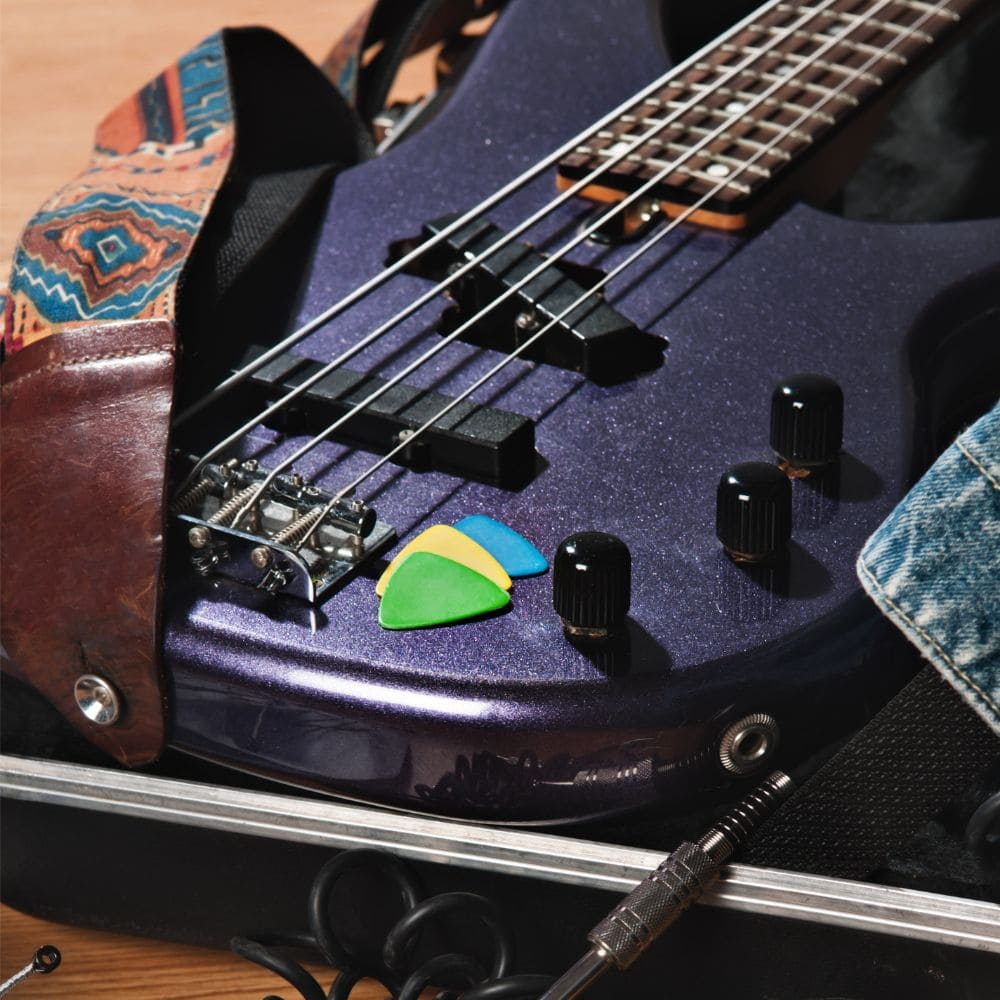Why Are Bass Picks Triangular?

Welcome to our comprehensive guide on bass picks and their unique shapes.
When it comes to playing the bass, there is an ongoing debate about whether to use a pick or play with your fingers. Both techniques have their merits, and the choice ultimately depends on individual playing styles and preferences.
Using a bass pick can offer greater precision and control, especially for fast-paced riffs and intricate melodies.
On the other hand, playing with fingers allows for a more organic and nuanced tone, with the ability to capture subtleties in the music. It's important for bass players to explore both methods and determine which best suits their musical expression and performance needs.
But assuming that you've decided to play with a pick, understanding why bass picks are triangular is a crucial aspect of optimizing playing experience and sound quality, making it an intriguing topic to explore.
In this article, we will delve into the materials and designs of bass picks, the significance of bass pick shape in playing, and conclude with key insights into this essential accessory for bass players.
Answer to the Question
In a nutshell, the triangular shape of bass picks exists due to the specific ergonomic and tonal requirements of playing the bass guitar. This design is tailored to offer superior grip and control while enhancing the sound quality when striking the strings.
I mean, imagine trying to play with a squared-shape pick, for example, where you risk hitting the string in more than one spot with each stroke?
Or consider a perfectly circular pick, where you'd struggle to get the precision that you'd get with the point of a triangle...
Material and Design of Bass Picks
Materials Used in Bass Picks
When it comes to bass picks, the choice of material is crucial in shaping the tonal characteristics, playability, and durability of the picks. Let's dive into the different materials commonly used in bass picks:
- Celluloid: Celluloid bass picks are known for their vintage aesthetic and warm, rounded tone. They offer a smooth feel and have been favored by many legendary bassists for their classic sound.
- Nylon: Bass picks crafted from nylon are valued for their flexibility and bright, articulate sound. They provide excellent dynamic range and are highly versatile, making them suitable for various playing styles.
- Delrin: Delrin bass picks are recognized for their durability and precision. They deliver a strong, focused attack and are preferred by players who require enhanced control and consistency in their playing.
- Ultex: Bass picks made from Ultex feature a rigid, contoured edge that promotes accuracy and speed. They produce a bright, powerful sound and are popular among bassists seeking clarity and definition in their playing.
Design of Bass Picks
When it comes to the design of bass picks, there are several key factors that contribute to their overall playability and tonal response. By understanding these design elements, bass players can make more informed choices based on their unique playing styles and preferences.
Let's delve into the specifics of bass pick design:
- Materials: Bass picks are crafted from a variety of materials, each offering distinct characteristics that influence their performance. Common materials include:
- Nylon: Known for its flexibility and smooth feel, nylon picks are favored for producing a warm, round tone.
- Delrin: Delrin picks provide a bright and articulate sound with enhanced durability, making them suitable for heavy playing.
- Celluloid: With a vintage aesthetic and a wide range of colors and patterns, celluloid picks offer a classic tone and a comfortable grip.
- Thickness and Shape: Bass picks come in various thicknesses and shapes, allowing players to tailor their performance to specific playing techniques and musical genres. Some common variations include:
- Standard: Medium-gauge picks that strike a balance between flexibility and robustness, suitable for a wide range of playing styles.
- Jazz III: Compact and pointed, Jazz III picks offer precision and control for intricate bass lines and fast-paced playing.
- Triangular: The triangular shape of picks enhances grip and maneuverability, facilitating dynamic playing and articulation.
- Texture and Grip: Many bass picks feature texturized surfaces or ergonomic contours to improve grip and stability during performances. This can be especially beneficial for players who prefer a secure hold on their picks while playing.
By considering these factors, bass players can select picks that align with their musical preferences, playing techniques, and tonal requirements, ultimately enhancing their playing experience and expression.
Importance of Bass Pick Shape in Playing
Grip and Control
The unique shape of bass picks plays a pivotal role in offering an ergonomic grip and heightened control over the instrument. The triangular form allows for seamless maneuverability, reducing the chance of slippage and optimizing playing technique for bassists.
Sound Quality
When it comes to sound quality, the shape of a bass pick plays a crucial role in defining the overall tonal characteristics of the bass guitar. The material and thickness of the pick also greatly influence the sound produced. Here are some key factors to consider:
- Material: Different materials, such as nylon, delrin, or celluloid, can produce varying degrees of warmth, brightness, and sustain. Understanding the sonic properties of different materials can help bassists achieve their desired tone. For example, nylon picks often provide a smoother and warmer sound, while delrin picks offer a brighter attack and increased durability.
- Thickness: The thickness of the pick affects the amount of give and flexibility, which in turn impacts the attack and response of the bass strings. Thicker picks can produce a more substantial and rounded tone, while thinner picks may offer greater agility and articulation.
- Edge Design: The edges of the pick can significantly influence the quality of sound and playability. A sharper edge can contribute to a more defined and focused sound, enhancing the clarity of individual notes and allowing for intricate playing techniques.
By carefully considering the interplay between the pick's shape, material, thickness, and edge design, bassists can tailor their sound to suit various playing styles and musical genres, ultimately elevating the overall sound quality and expression of their bass guitar.
Conclusion
As we conclude our exploration of bass picks and their triangular shape, it becomes evident that this specialized design is integral to the versatile capabilities and sonic nuances of the bass guitar. By understanding the materials, design elements, and functional significance of triangular bass picks, musicians can elevate their playing experience and artistic expression with enhanced finesse and tonal richness.
Ready to get a new pick of your own? Check out the best bass picks currently available.
*FYI, when you make a qualifying purchase through one of our links, we might receive a small commission from Amazon or other retailers, at no additional cost to you, which helps us to fund this site. It's a way to find what you're looking for while supporting us in the process!
